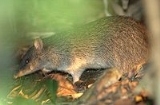
Bandicoot
Overview
Bandicoots are a group of about 20 species of small to medium-sized, terrestrial marsupial
omnivore
s in the order Peramelemorphia
.
The word itself is often used as a common name for any of them, and is an anglicised form of the Telugu
word (పందికొక్కు) (pandi-kokku).pandi-kokku, (loosely, pig
-rat
), which originally referred to the unrelated Indian Bandicoot Rat. The other two species of peramelemorphs are the bilbies
.
Their fur is short and usually brown, yellow or black.
The embryo
s of bandicoots, unlike other marsupials, form a placenta
-like organ that connects it to the uterine
wall.
Marsupial
Marsupials are an infraclass of mammals, characterized by giving birth to relatively undeveloped young. Close to 70% of the 334 extant species occur in Australia, New Guinea, and nearby islands, with the remaining 100 found in the Americas, primarily in South America, but with thirteen in Central...
omnivore
Omnivore
Omnivores are species that eat both plants and animals as their primary food source...
s in the order Peramelemorphia
Peramelemorphia
The order Peramelemorphia includes the bandicoots and bilbies: it equates approximately to the mainstream of marsupial omnivores...
.
The word itself is often used as a common name for any of them, and is an anglicised form of the Telugu
Telugu language
Telugu is a Central Dravidian language primarily spoken in the state of Andhra Pradesh, India, where it is an official language. It is also spoken in the neighbouring states of Chattisgarh, Karnataka, Maharashtra, Orissa and Tamil Nadu...
word (పందికొక్కు) (pandi-kokku).pandi-kokku, (loosely, pig
Pig
A pig is any of the animals in the genus Sus, within the Suidae family of even-toed ungulates. Pigs include the domestic pig, its ancestor the wild boar, and several other wild relatives...
-rat
Rat
Rats are various medium-sized, long-tailed rodents of the superfamily Muroidea. "True rats" are members of the genus Rattus, the most important of which to humans are the black rat, Rattus rattus, and the brown rat, Rattus norvegicus...
), which originally referred to the unrelated Indian Bandicoot Rat. The other two species of peramelemorphs are the bilbies
Bilby
Bilbies are desert-dwelling marsupial omnivores; they are members of the order Peramelemorphia. Before European colonisation of Australia, there were two species. One became extinct in the 1950s; the other survives but remains endangered....
.
Their fur is short and usually brown, yellow or black.
The embryo
Embryo
An embryo is a multicellular diploid eukaryote in its earliest stage of development, from the time of first cell division until birth, hatching, or germination...
s of bandicoots, unlike other marsupials, form a placenta
Placenta
The placenta is an organ that connects the developing fetus to the uterine wall to allow nutrient uptake, waste elimination, and gas exchange via the mother's blood supply. "True" placentas are a defining characteristic of eutherian or "placental" mammals, but are also found in some snakes and...
-like organ that connects it to the uterine
Uterus
The uterus or womb is a major female hormone-responsive reproductive sex organ of most mammals including humans. One end, the cervix, opens into the vagina, while the other is connected to one or both fallopian tubes, depending on the species...
wall.
Unanswered Questions

